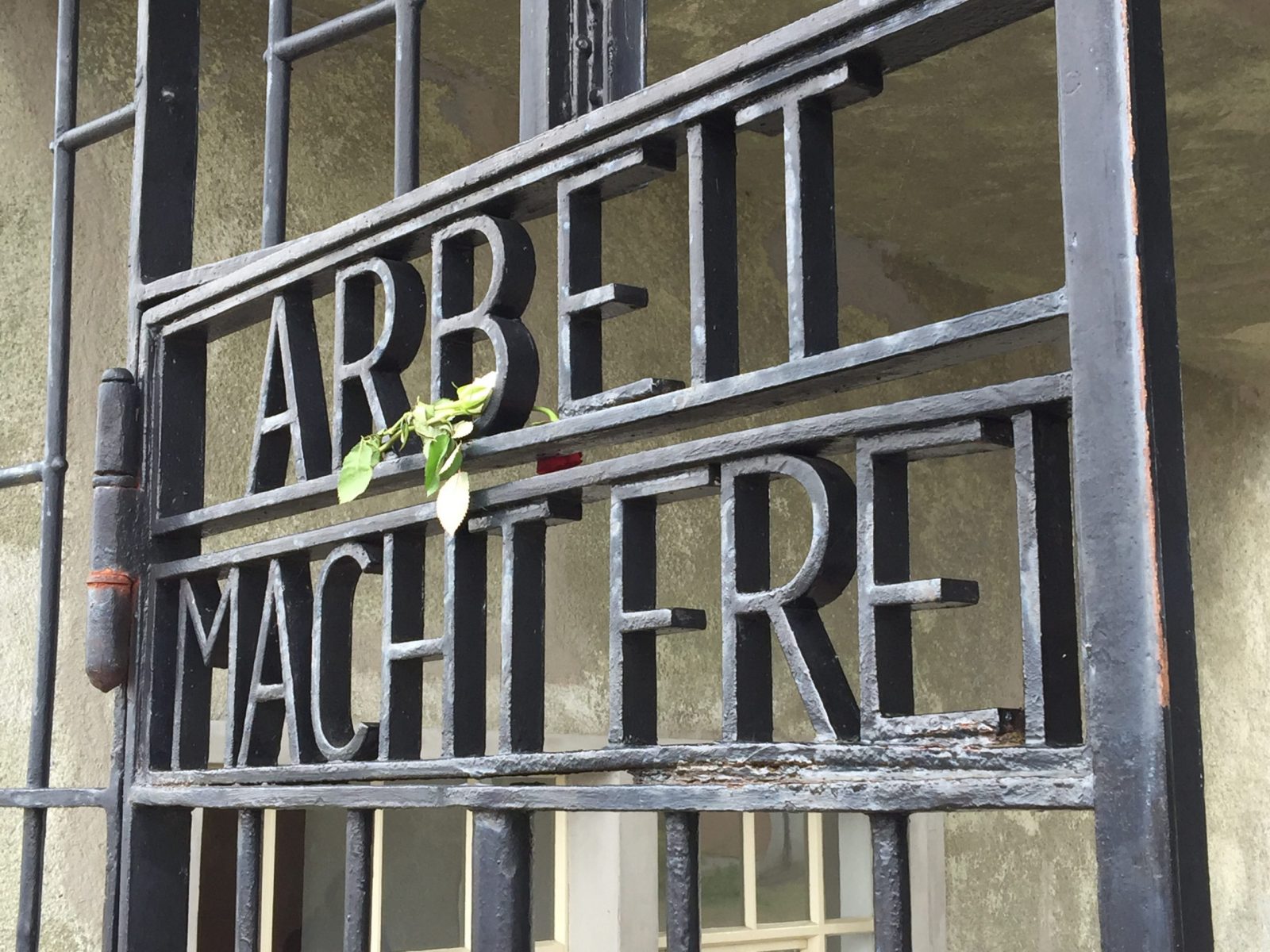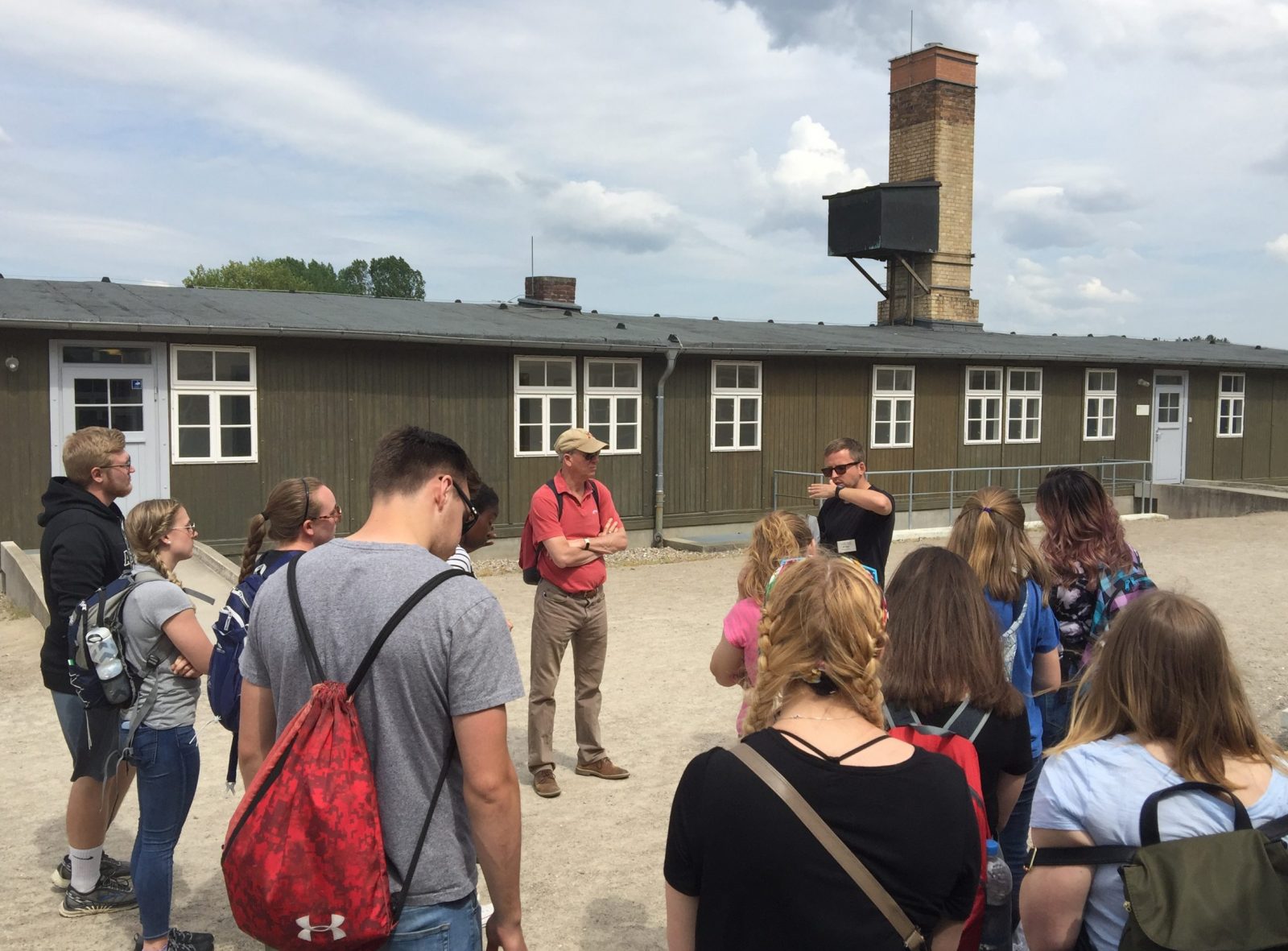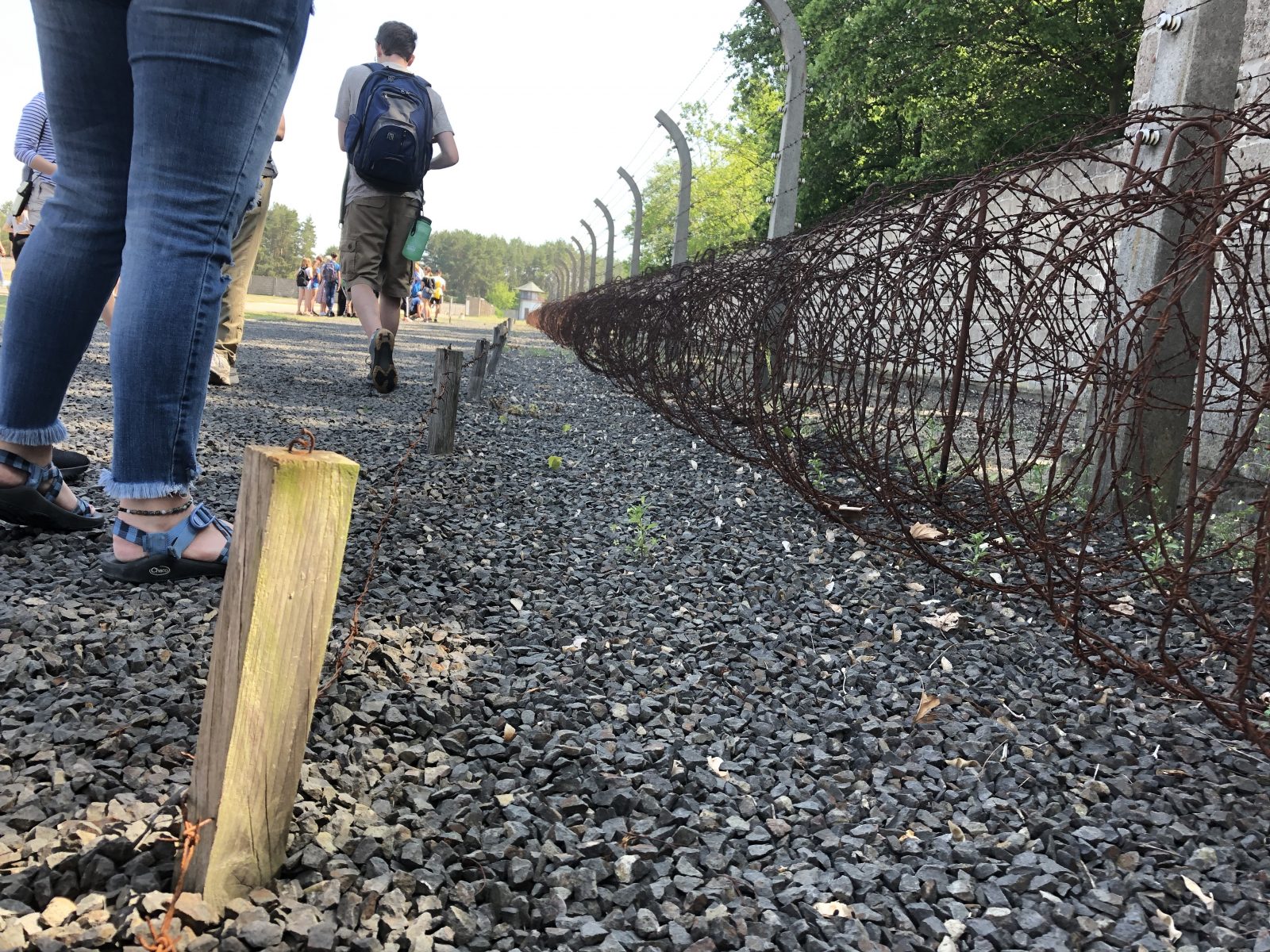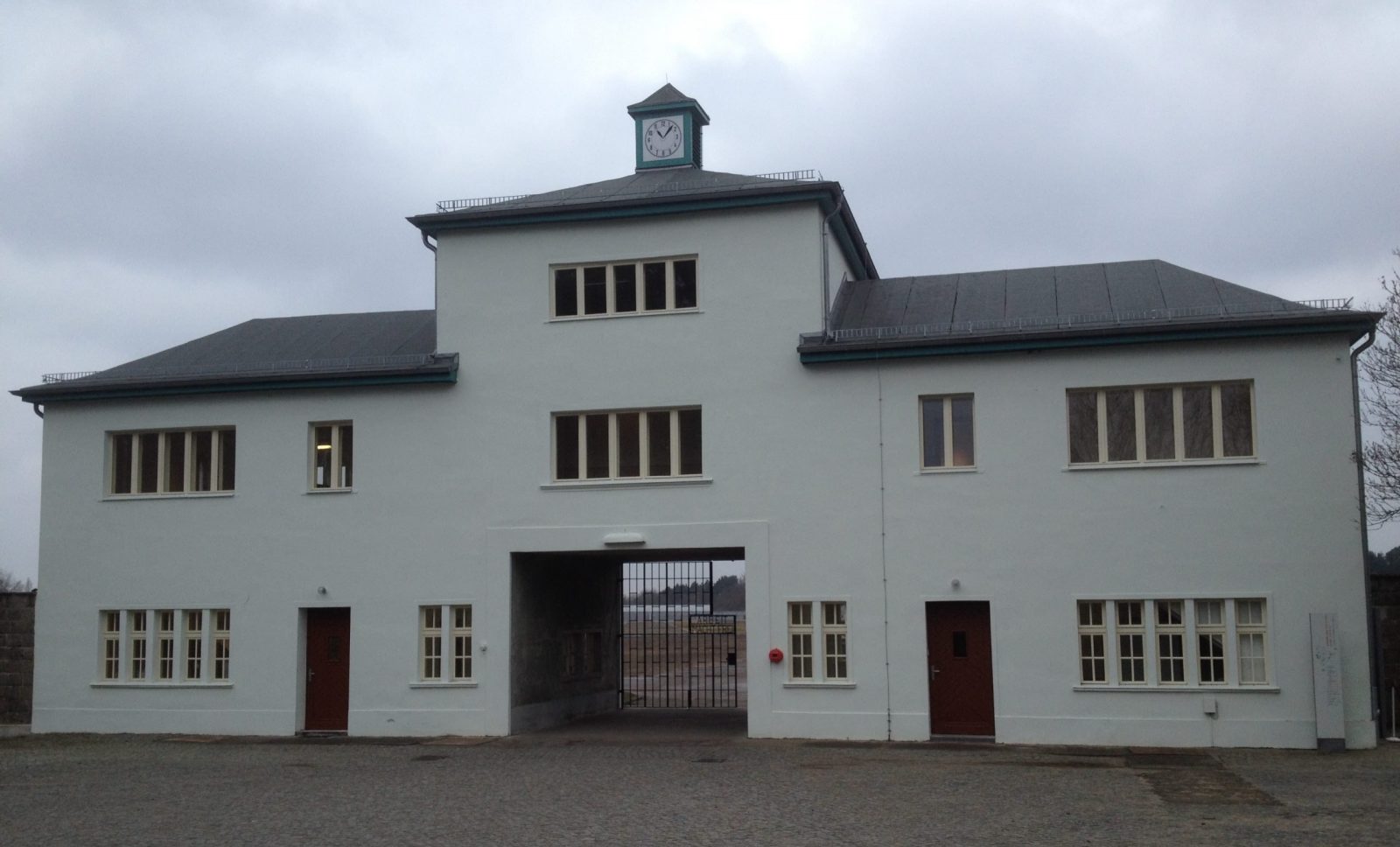
Typically, on about the third day of a tour, we visit our first concentration camp, Sachsenhausen. It is located in Oranienburg, a medium-sized medieval city that sits on the banks of the Havel River, just a few kilometers north of the capital; easily accessed with only a Berlin City Rail pass. Sachsenhausen, one of the earliest camps built by the National Socialists, was originally designed to house political prisoners. Over the years, the categories of occupants broadened to include prisoners of war as well as perceived racial and social threats to the state. However, the underlying and all-governing purpose for the camp never changed; people were only sent there for one reason – to be worked to death.
The camp itself is located about 2-kilometers from the train station. The path we walk from the platform to the camp is the same one prisoners used when they were being marched to their confinement. During the camp’s operation (1936 – 1945), it was a well-worn path; in total, about 200,000 people were imprisoned there at one time or another. As we make our way along a major city street in front of numerous shops and businesses and finally through a quaint neighborhood to the camp gate, the students quickly realize that the reception of prisoners was not only a frequent event, but also a rather public one.
Although a visit to any concentration camp naturally produces a deluge of questions, after our visit to this camp, I typically ask students to consider what it must have been like to be a resident of Oranienburg when Sachsenhausen was in operation. The very existence of a walled camp with armed guard towers, the one-way flow of people into the camp, and the frequently billowing smoke stacks, were ever-present facts. What were the locals to make of this? Could they not have known what was happening? We may shake our heads in disbelief, but that is precisely the claim made by town residents. Oranienburg citizens, in fact most German citizens across the country, emphatically stated that they had no idea as to the full extent of what was going on.

Many of my students are surprised to learn that there were actually several hundred forced labor camps across Germany. For every recognizable large camp like Sachsenhausen, Buchenwald, or Dachau, there were dozens and dozens of smaller satellite camps. Sachsenhausen, for instance, was associated with about 70 sub-camps sprinkled throughout the surrounding communities. On the rare occasions when a few prisoners were actually marched away from camp, it was most likely to resupply a sub camp where the previous prisoners had perished from exhaustion. All across Germany there were emaciated people in striped clothing being solemnly moved from place to place, and yet, no one knew what was going on. The assertion of ignorance is considered one of the great lies the Germans citizens told themselves concerning the war.
Although the astonishing and deeply troubling non-response of the German population can lead to discussions about all sorts of topics, including self-deception and the conforming power of situations, as students reflect upon Sachsenhausen I invite them to consider the role of familiarity, or commonness, in the perpetuation of evil.
The possibility that systemic wrongdoing can be casually woven into a person’s or community’s daily routine is a startling thing to consider. We seem prone to want to believe that the forces of evil prompting terrible behavior and misconduct present themselves to us in recognizable fashion, like the wicked witches of fairy tales or Orcs from Middle Earth. As we wish to understand it, the forces of evil are clearly identifiable, they are external to us, and our job is to summon up the moral courage to fight them. We do not want to consider that an evil agenda can be effectively operationalized by seeping into our own lives, either as an unnoticed habit or as a slight concession commingled with obviously good and admired activities. Yet, it is undoubtedly true that people subtlety make accommodations for or practice acquiescence with bad behavior and then gradually develop corresponding attitudes and beliefs that insulate their behavior from scrutiny. The citizens of Oranienburg were loyal Germans in a time of hardship. The nation’s wounds were being healed, its’ disgraced international position was being rehabilitated through the hard work and solidarity of its real citizens, jobs were being created, infrastructure was being built, and the German family and culture was being exalted. These were good things. In a phrase, Germany was being made great once again. The striped zombies and barbed wire quickly faded into the backdrop of the imagined beauty and national restoration that was coming into focus.
The lesson of Sachsenhausen and the people of Oranienburg should prompt an analysis of our own lives and our own communities. What common evils might we have casually woven into our daily lives? When I ask students this, typically racism and other “isms” quickly jump to mind, and, in one sense, rightly so. Our culture is currently wrestling with the ugly history and legacy of demographic-based biases and privileges. Historically, these terribly unfair practices and systemic slights often did travel under the social moral radar. Moreover, as a culture we are bringing greater and greater scrutiny to bear on the extent of the entrenchment of these biases. Doing the hard work to wrestle these ugly traits out into the light and then to strive to establish fairness and care for the marginalized is unquestionably a good endeavor, and one that fits well in a diverse culture that is struggling to create social harmony. However, should not the lesson of Sachsenhausen prompt us to look deeper than just the moral failings that have gained public awareness and social traction? The crux of the lesson, after all, is that evil can be very effective when it is subtle and unnoticed, when it has worked its way into the unexamined backdrop of our moral lives. Excavation of these offenses will now take a concerted effort. In fact, our failings would only be discoverable if we first allowed ourselves to consider the possibility that they could be there, and then only if we are determined enough to go looking for them. Here the moral guardrails and warning lights furnished by the surrounding culture may not be of help.

In addition to the values of fairness and care that currently register bright on the cultural radar, moral psychologists have identified additional dimensions of the human moral framework (e.g., Haidt, 2009); and many of these are not often detected by the public moral life of a pluralistic society. For instance, there is the issue of sanctity versus degradation. Understandably, this concept does not easily rise to awareness within a spiritually diverse culture. Yet, the question should still present itself. Is there sacredness in the world, and if so, how I am treating that which is sacred? Is my body sacred? Should I understand other people’s bodies as sacred? Is there a sacredness to certain social institutions and certain activities? The morality memes of the larger culture may be of little use here. Or take loyalty versus betrayal. Our rabidly individualist culture is not likely to prompt sober consideration of our obligations to the social bonds that tie us together. How might we have allowed betrayal to creep its way into our familial, fraternal, and contractual relationships? And here’s a particularly hard one, authority versus subversion. The loss of trust in so many of our institutions is so great that for anyone to suggest there is a proper role for authority in our lives may strike us as odd, and probably manipulative. However, effective social systems, from families on up, require the concept of authority. Are we properly respecting the authorities in our life? Are there appropriate authorities we need to respect?
These other aspects of the moral life are not often referenced in a pluralistic and post-modern culture. In our quest to live properly, we, like the wartime residents of Oranienburg, will not be able to rely simply on a public morality for guidance and correction. We will have to train ourselves to look elsewhere; that is, if we first have the will to care about these dimensions.
Deeper dives of exploration concerning the particularities of the Holocaust are beneficial, not only as an opportunity to find greater sympathy and solidarity with the victims, but also as a means by which to shine light on and see with greater acuity the darkness of the human condition, to feel it up close and personal, perhaps even detecting one’s own shadow along the way. After all, it is only those who have first found themselves sick who will then go out looking for a cure.

Haidt, J. (2009). The righteous mind: Why good people are divided by politics and religion. New York: Pantheon Books.